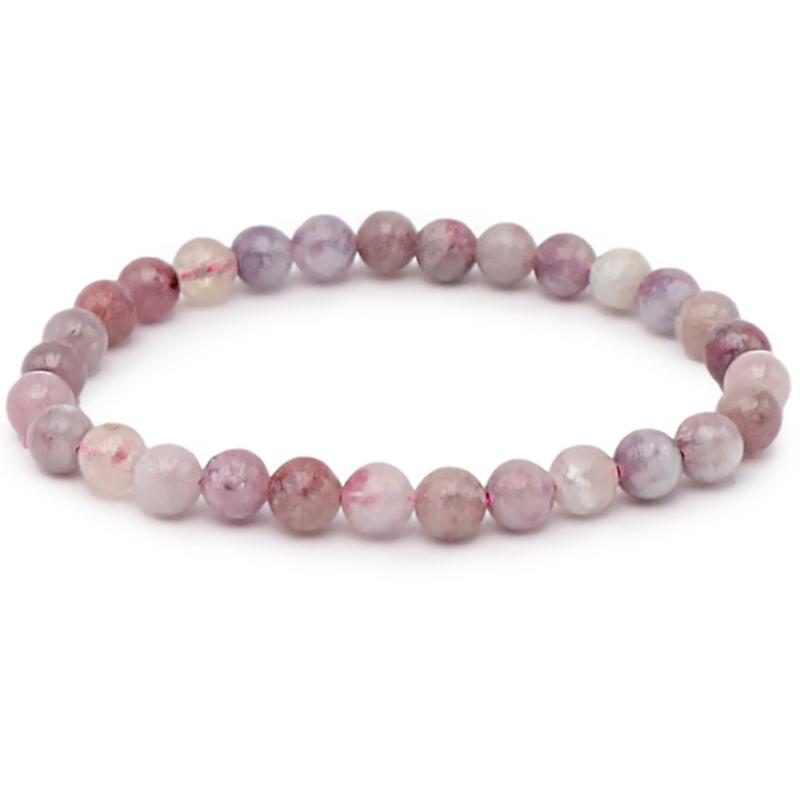Pink tourmaline bracelet on Eudialyte Namibia A (5-6mm balls)
BRA-TOUREUD-02
- Regular price
-
19,90 € - Regular price
-
19,90 € - Sale price
-
19,90 €
Couldn't load pickup availability
Learn more
BRA-TOUREUD-02
Origin: Namibia
Grade: A
Dimensions:
Approximately 18cm - Fits all wrists from 17 to 19cm.
Patterns and colors may vary from one bracelet to another.
The name tourmaline comes from “turmali” or “turamali” which is in fact a Sinhalese name given to this fabulous stone from Sri Lanka by Dutch explorers at the beginning of the 18th century.
In Sri Lanka, a legend says that tourmaline comes from the sky and during its descent to earth, it crossed a rainbow which transmitted its color variations. Which explains the origin of its name meaning “the stone of a thousand colors”.
In fact, tourmaline has been known for millennia. In the 3rd century BC, we found traces of this stone. In Greece, it was Alexander the Great (356-323 BC) who brought back this stone from these expeditions. However, tourmaline, due to its many colors, has very often been confused with other minerals.
Thus, there are very few legends or myths attached to this stone due to its late identification. However, some tourmalines have piezoelectric properties, meaning they have an electric charge, negative at one pole and positive at the other pole. Tourmaline attracts particles to itself.
When the philosopher Theophrastus (-322 to -288) describes a stone having the ability to attract pieces of straw or pieces of wood to itself, we understand that he is talking about tourmaline. Later in the 18th century, Dutch explorers used tourmaline to clean their pipes because the stone attracted ashes.
For the record, in the 16th century, a Spanish conquistador discovered a green tourmaline in Brazil, which he identified as an emerald. This discovery caused a rush in the Brazilian regions in search of these famous emeralds. The error was corrected in the 19th century and the emeralds were transformed into tourmalines.
Many times confused with precious stones, tourmalines are therefore found in many jewelry, and even in the British crown. We can also mention the Timur Ruby, a 352-carat jewel that was thought to be a ruby until 1851, or the 170-carat Black Prince ruby which is actually a tourmaline.
Tourmaline is causing more and more enthusiasm among connoisseurs and collectors. Thus, the Empress of China Cixi (1861-1908) loved this stone so much that she began to collect it. She asked for sculptures, brooches, watch straps, rings, etc. to be made for her. Today it rests on a cushion of tourmalines.
Tourmaline comes in various shades. They can also be two-tone or multi-colored. There is a wide variety of tourmalines, in different colors, from opaque to transparent, with striated or hexagonal structures. It has a rhombohedral crystal system. It is a magmatic and metamorphic rock which may come from hydrothermal deposits.
Thus, there are several kinds of tourmalines with varied compositions such as magnesium silicates, sodium silicates, iron, clay, fluorides and borosilicate. Tourmalines are actually an entire family of stones, which have the same internal structure, but differ in chemical composition and therefore in color and appearance.
The main deposits are located in Brazil, Afghanistan, Australia, Brazil, Russia, Thailand, Burma, Madagascar, India, and the United States.
Tourmaline is a stone often associated with other minerals. The most common combinations are pink tourmaline on eudialyte, pink tourmaline on lepidolite and pink tourmaline on rose quartz.
You can find all the characteristics of pink tourmaline in the text dedicated to it. We will focus more particularly on the benefits of these minerals which accompany these pink tourmalines.
The marriage of pink tourmaline and eudialyte reinforces the effectiveness of both stones. We have previously seen the properties of pink tourmaline. We are going to develop those for eudialyte.
Eudialyte is a variety of pink garnet, which has the particularity of being often associated with various other minerals, in this case pink tourmaline. Its pink is darker and it sometimes turns brown, but this remains quite rare.
The name eudialyte comes from the Greek meaning good and dissolvable. It is part of the silicates group, subgroup of cyclosilicates. It is soluble in acids, hence its name. It was identified by Friedrich Strohmeyer in 1818 following the discovery of a specimen from the southwest coast of Greenland.
Eudialyte is composed of cyclosilicates of sodium, calcium, cerium, iron, manganese and zirconium. It has a hardness of 5.5 on the Mohs scale. In comparison, diamond has the highest hardness on this same scale, 10.
It is a relatively affordable stone, even mounted as jewelry. However, some high quality pendants can reach hundreds of euros.
Its main deposits are located in Russia, Canada, the United States and Greenland.
The benefits of pink tourmaline (refer to the text on pink tourmaline) are coupled with those of eudialyte. Eudialyte helps release negative emotions, such as anxiety. Associated with pink tourmaline, it encourages introspection and reconnection with the inner self. It generates an understanding of traumas often linked to childhood.
Thus, it is ideal for making a fresh start. It helps to overcome grief, suffering and guilt. Pink tourmaline on eudialyte is a stone of resilience. It allows you to rebuild yourself both emotionally and professionally. It gives the courage to undertake. It is a stone of liberation that helps overcome grief and doubts. It restores self-confidence.


Pink tourmaline bracelet on Eudialyte Namibia A (5-6mm balls)
- Regular price
-
19,90 € - Regular price
-
19,90 € - Sale price
-
19,90 €
-
100% SECURE PAYMENT
Paypal, credit card, check, transfer
-
FREE DELIVERY
from 40€ purchase
-
SATISFIED OR REFUNDED
14 days to change your mind
-
CUSTOMER SERVICE AVAILABLE
contact@laboiteacailloux.com
to receive all our offers, good deals and new products from La Boite à Cailloux


